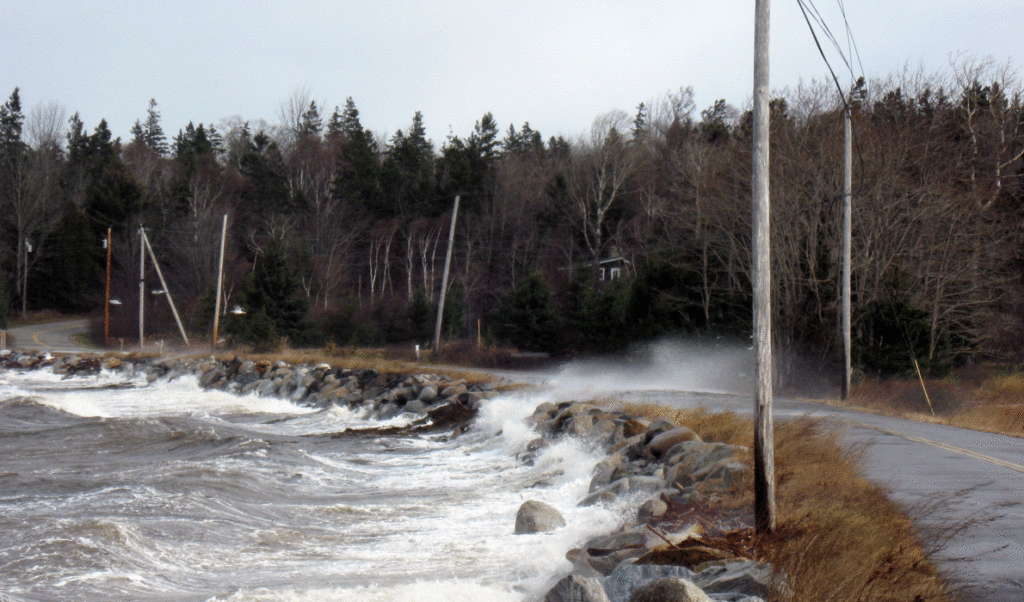By Susie Arnold, Kate Tagai, and Allison Carmen
Rising ocean levels and increasing storm frequency and intensity are already having an impact along the Maine coast. How we choose to adapt and improve our coastal infrastructure will determine how our communities succeed.
Traditional approaches to improving built infrastructure include increasing the diameter of culverts to allow for greater storm water runoff, raising road levels, docks,and coastal buildings to account for rising tides, and building retaining walls. But some communities are looking beyond these basic upgrades and are beginning to test new innovative solutions.
Businesses that rely on the waterfront can’t simply relocate to higher ground—they must adapt to the flood plain. The Front Street Shipyard in Belfast took an innovative approach when building a new 22,500-square-foot boat shed.
Working with the city to get a variance to the flood zone, the business designed a building that would allow the higher tides to run right through it. The lower portion of the wall has swinging stainless-steel louvers, and all the construction materials used on the lower six feet of the wall can withstand getting wet without impacting the integrity of the building.
“People always wonder why the outlets are so high,” jokes JB Turner, Front Street Shipyard’s president. “All the light switches and power outlets in the building are at a minimum 6-feet height.”
These upgrades allow the tides to rise and fall and work to continue without interruption, saving Front Street Shipyard money both in worker time and the cost of repairs. By adapting to its environment, the business is becoming economically resilient.
On the other side of the country, landscape architect Kristina Hill is reimagining the San Francisco Bay area using natural environments to work in collaboration with built infrastructure in a system she calls “hybrid edges.” Using wetlands and beaches to provide buffers for houses that are built on piled foundations rather than dug foundations, her designs use living systems as a component of infrastructure. With 39 percent of the U.S. population living along the shore, it is becoming increasingly important to work with the environment rather than in spite of it.
The Dutch have long adapted to a watery landscape from dikes to dynamic floodgates, and are now developing strategies to make themselves climate proof. Much of the Netherlands is actually below the current sea level, making it especially vulnerable to its rise. Leaders there are changing how they think about hard surfaces, storm water runoff, and how to let water in strategically, like the Front Street Shipyard, rather than try to block it out altogether.
A 22-acre expanse of fields and canals, called the Eendragtspolder, recently hosted the World Rowing Championships. But its primary purpose is to absorb excess storm water in a place without built infrastructure that can be undermined, damaged, or washed away.
The Dutch realized that building higher levees to contain the water would effectively wall off the city. Though they are increasing the height of floodgates, they also are creating strategic places where the river can flood. By creating wells for excess storm water run-off to be absorbed, they don’t have to depend entirely on the integrity and maintenance of built infrastructure like dikes or levees.
The Floating Farm in Rotterdam is a bold design concept that addresses decreasing availability of arable land. In fact, the farm isn’t located on land at all, but is built on three floats above the water with space for 40 dairy cows. The designers are creating a farm with closed loops, so the fertilizer the cows produce goes into growing grass for them to eat. It also can be fermented to create electricity to power the farm.
The U.S. spends billions on disaster recovery every year, only to watch the infrastructure get inundated and rebuilt again a few years later. We need to start adapting rather than replacing. Municipalities, businesses, and private home owners must choose to prioritize investing some of the billions up front to create more resilient roads, houses, businesses, and cities.
Ultimately, spending a little more now may prove to be more cost effective in the long run. We will be looking to countries like the Netherlands, businesses like Front Street Shipyard, and professionals like Kristina Hill to continue to lead the way with new ideas.
Susie Arnold is a marine scientist, Kate Tagai is a senior community development officer, and Allison Carmen is an infrastructure finance specialist with the Island Institute.





